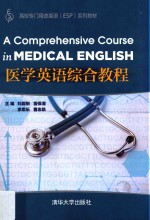

高校专门用途英语(ESP)系列教材 医学英语综合教程PDF电子书下载
- 电子书积分:10 积分如何计算积分?
- 作 者:刘殿刚,雷保清,李思乐,曹忠凯,李德俊编
- 出 版 社:北京:清华大学出版社
- 出版年份:2017
- ISBN:9787302474388
- 页数:232 页
Unit One Fundamentals of Traditional Chinese Medicine 1
Part Ⅰ Reading Skills 2
Cultivating a Good Reading Habit 2
Part Ⅱ Text Study 4
A Brief Introduction to Traditional Chinese Medicine 4
Part Ⅲ Lexical Study 13
英语构词法(Word Formation) 13
Part Ⅳ Translation Techniques 15
中医药术语翻译方法简介(English Translation of TCM Terms) 15
Part Ⅴ Writing Practice 18
摘要(Abstract) 18
Unit Two Biology 23
Part Ⅰ Reading Skills 24
Predicting While Reading 24
Part Ⅱ Text Study 26
Reconceptualizing Major Depressive Disorder as an Infectious Disease 26
Part Ⅲ Lexical Study 34
词根(一)(Root Ⅰ) 34
Part Ⅳ Translation Techniques 36
增译法(Amplification) 36
Part Ⅴ Writing Practice 39
引言(Introduction) 39
Unit Three Physiology 43
Part Ⅰ Reading Skills 44
Finding Out the Topic Sentence of a Paragraph 44
Part Ⅱ Text Study 46
An Overview on Homeostasis 46
Part Ⅲ Lexical Study 56
词根(二)(Root Ⅱ) 56
Part Ⅳ Translation Techniques 58
省译法(Omission) 58
Part Ⅴ Writing Practice 60
研究方法(Methodology) 60
Unit Four Diagnostics of Traditional Chinese Medicine 65
Part Ⅰ Reading Skills 66
Summarizing the Main Idea of a Paragraph 66
Part Ⅱ Text Study 67
The Significance of Traditional Pulse Diagnosis in the Modern Practice of Chinese Medicine 67
Part Ⅲ Lexical Study 76
词缀(Affix) 76
Part Ⅳ Translation Techniques 79
词类转换法(Conversion of Parts of Speech) 79
Part Ⅴ Writing Practice 82
研究结果(Result) 82
Unit Five Anatomy 85
Part Ⅰ Reading Skills 86
Detailed Reading 86
Part Ⅱ Text Study 87
Introductory Anatomy: Terminology 87
Part Ⅲ Lexical Study 95
后缀(Suffix) 95
Part Ⅳ Translation Techniques 97
词序调整法(Adjustment of Word Order) 97
Part Ⅴ Writing Practice 99
讨论(Discussion) 99
Unit Six Pathology 103
Part Ⅰ Reading Skills 104
Guessing the Meaning of Words from Context 104
Part Ⅱ Text Study 106
The Utility of Serial Blood Film Testing for the Diagnosis of Malaria 106
Part Ⅲ Lexical Study 114
派生法(Derivation) 114
Part Ⅳ Translation Techniques 115
语态转换法(Translation of Passive Voice) 115
Part Ⅴ Writing Practice 118
投稿(Submission) 118
Unit Seven Chinese Herbology 123
Part Ⅰ Reading Skills 124
Drawing Inferences 124
Part Ⅱ Text Study 128
An Introduction to Chinese Herbs 128
Part Ⅲ Lexical Study 137
转类法(Conversion) 137
Part Ⅳ Translation Techniques 139
断句译法(Splitting of a Sentence) 139
Part Ⅴ Writing Practice 142
修稿(Revision) 142
Unit Eight Pharmacology 149
Part Ⅰ Reading Skills 150
Skimming 150
Part Ⅱ Text Study 152
Effect of Novobiocin on the Viability of Human Gingival Fibroblasts(HGF-1) 152
Part Ⅲ Lexical Study 163
合成法(Compounding) 163
Part Ⅳ Translation Techniques 165
合句译法(Sentence Combination) 165
Part Ⅴ Writing Practice 168
病例报告(Case Report) 168
Unit Nine Acupuncture 175
Part Ⅰ Reading Skills 176
Scanning 176
Part Ⅱ Text Study 177
Acupuncture——A Critical Analysis 177
Part Ⅲ Lexical Study 190
缩略法(Abbreviation) 190
Part Ⅳ Translation Techniques 191
补全译法(Complementation) 191
Part Ⅴ Writing Practice 194
简讯和简报(Newsletter and Brief Notice) 194
Unit Ten Immunology 197
Part Ⅰ Reading Skills 198
Organization of the Text 198
Part Ⅱ Text Study 200
Perspective: Principles of Ecological Immunology 200
Part Ⅲ Lexical Study 211
逆成法(Back Formation) 211
Part Ⅳ Translation Techniques 212
正反译法(Positive and Negative Translation) 212
Part Ⅴ Writing Practice 215
国际会议(International Conference) 215
Key to Exercises 217
Glossary 228
- 《家畜百宝 猪、牛、羊、鸡的综合利用》山西省商业厅组织技术处编著 1959
- 《高级英语阅读与听说教程》刘秀梅编著 2019
- 《全国高等中医药行业“十三五”创新教材 中医药学概论》翟华强 2019
- 《看图自学吉他弹唱教程》陈飞编著 2019
- 《激光加工实训技能指导理实一体化教程 下》王秀军,徐永红主编;刘波,刘克生副主编 2017
- 《AutoCAD 2019 循序渐进教程》雷焕平,吴昌松,陈兴奎主编 2019
- 《少儿电子琴入门教程 双色图解版》灌木文化 2019
- 《MBA大师.2020年MBAMPAMPAcc管理类联考专用辅导教材 数学考点精讲》(中国)董璞 2019
- 《Photoshop CC 2018基础教程》温培利,付华编著 2019
- 《党员干部理论学习培训教材 理论热点问题党员干部学习辅导》(中国)胡磊 2018
- 《联吡啶基钌光敏染料的结构与性能的理论研究》李明霞 2019
- 《区块链DAPP开发入门、代码实现、场景应用》李万胜著 2019
- 《儿歌弹唱》黄克宏,李素霞主编 2018
- 《弗里达·卡罗》(加)苏珊娜·巴贝扎特著;朱一凡,玩静雯,李梦幻译 2020
- 《行测资料分析》李永新主编 2019
- 《饲养栽培图鉴》李志丹责任编辑;申文淑译;(日本)有泽重雄,月本佳代美 2019
- 《电贝司》李杰,李国标,杨昌明编 2019
- 《换一种教法》姜风平,侯丙生,李长宾 2013
- 《丹砂古寨 贵州务川龙潭仡佬族村民族志研究》李劲松著 2019
- 《中国科学院规划教材·大学数学系列教材 高等数学 第2版》(中国)马少军,张好治,李福乐 2019
- 《大学计算机实验指导及习题解答》曹成志,宋长龙 2019
- 《指向核心素养 北京十一学校名师教学设计 英语 七年级 上 配人教版》周志英总主编 2019
- 《大学生心理健康与人生发展》王琳责任编辑;(中国)肖宇 2019
- 《大学英语四级考试全真试题 标准模拟 四级》汪开虎主编 2012
- 《大学英语教学的跨文化交际视角研究与创新发展》许丽云,刘枫,尚利明著 2020
- 《北京生态环境保护》《北京环境保护丛书》编委会编著 2018
- 《复旦大学新闻学院教授学术丛书 新闻实务随想录》刘海贵 2019
- 《大学英语综合教程 1》王佃春,骆敏主编 2015
- 《大学物理简明教程 下 第2版》施卫主编 2020
- 《指向核心素养 北京十一学校名师教学设计 英语 九年级 上 配人教版》周志英总主编 2019
